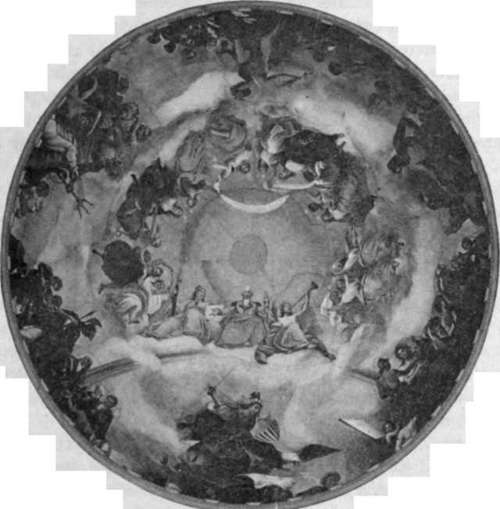The Canopy, Apotheosis Of Washington
Description
This section is from the book "The National Capitol. Its Architecture Art And History", by George C. Hazelton, Jr. Also available from Amazon: The National Capitol Its Architecture Art and History.
The Canopy, Apotheosis Of Washington
The canopy which forms the ceiling of the rotunda was finished by Brumidi in 1865. This conception of the artist, because of its great height from the observer, was drawn in heroic proportions. It represents the beatification of the spirit of George Washington, who is seated in the center. On his right sits Freedom and on his left Victory ; while grouped about are thirteen female figures emblematic of the thirteen original States. On the banneret stretching across the picture are the words " E Pluribus Unum".
Around the base of the canopy are groups suggestive of the spirit of revolution and its resulting progress, as beheld in the history of the young Republic : armed Liberty with shield and sword conquering Royalty, the armored soldier in vain endeavoring to uphold the ermine at which the eagle with outstretched wings strikes with beak and claws; Minerva, the Goddess of Arts and Sciences; Ceres, of the Harvest; Mercury, the Messenger of the Gods, representing Eloquence and Commerce; Vulcan, the God of Mechanics; and Neptune, with his trident, the God of the Marine.
Just before his death, Brumidi was criticised, especially in the papers of the South, for an alleged caricature of the leaders of the Confederacy. Though the artist always denied the accusation, it is interesting to observe the resemblance of the figures to the right of armed Liberty to Jefferson Davis and Alexander H. Stephens, the President and Vice-President of the Confederacy, and of the two figures to the left to General Robert E. Lee and John B. Floyd, the Secretary of War under Buchanan. The scene itself is certiinly suggestive of the stamping out of the Rebellion : a thunder-bolt, representing the wrath of the Gods, is being hurled from on high at Stephens; while the President of the Confederacy, with a lighted torch, is fleeing from the wrath of the colossal figure of armed Liberty above. But it is not possible that Brumidi intended these as portraits; for he was the friend of most of the Confederate leaders, and probably the last to see Jefferson Davis before he left the capital for the South. When the artist first came to Washington to reside, the government was in the hands of the men who afterwards led in the Confederacy. He became intimate with them, and found them more congenial than many of Northern birth; for their temperaments were warm and Italian like his own. Nor, on the other hand, can he be justly accused of disloyalty to the Union; for he left Italy because of his republicanism, as his father before him fled from Greece for the like good cause, and it is not possible that a spirit so imbued would uphold slavery in its adopted country.

THE CANOPY.
In the group of Arts and Sciences are clearly portrayed by the artist's intention the features of Franklin, Fulton and Morse, that trio who, more than any other, has annihilated space and conquered time. The face of Vulcan in the group representing Mechanics is thought by many strongly to suggest T. U. Walter, the architect of the marble extensions and the new dome, though he strenuously objected to the commemoration of his features by his artist-friend on the ceiling of the rotunda. Two figures in the group of Commerce are thought to be those of Robert Morris, the great financier of the Revolution, who spent his last days in a debtor's cell, and of Alexander Hamilton, the organizer of the Treasury Department of the United States. The statement that the fair faces of the maidens depicted in this fresco are likenesses of the sweethearts of the artist at various periods of his romantic career, cannot be authenticated, and probably the suggestion has arisen from the fact that Brumidi used many attractive models in drawing his designs.
The groundwork upon which this fresco is executed is of copper covered with plaster. The canopy is like a huge bowl in appearance, 65 feet in diameter, with a concavity of nearly 21 feet; and the distance from its center to the center of the floor of the rotunda is 180 feet 3 inches. The artist's contract price was $39,500. It is almost the only piece of work which Brumidi performed in the Capitol for which he received other than a per diem compensation of ten dollars.
Continue to:
- prev: Fresco
- Table of Contents
- next: The Frieze
